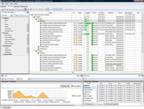Project management methodology definition: it is an in-depth pattern (model) that recommends and represents the elaborated system of certain approaches, attitudes and tools framed up with a help of specifically adjusted working-style accepted to drive this method. There are lots of widely-known and exclusive (or proprietorial) PM types where a number of the most used ones includes examples such as Waterfall, RUP, Prince2, Scrum, and dozen of others. If you would like to have a brief comparison and overview, then this article is right for you. Let’s shortly consider examples in the following list explaining basics of some popular models: Waterfall (originally the software development methodology, but can be used in other areas as well): This is a traditional model (elaborated from the classic project management approach) describing a project development as a linear and sequential process with sub-processes and special phases. Waterfall model sets distinct goals for each of one-by-one phases of project evolution; these phases include Requirements, Design, Implementation, Verification, Maintenance (progress flows from the top phase to the bottom one, like a waterfall). Each phase of development proceeds in strict order, without any overlapping or iterative steps, and working process cannot be back once it appears on certain stage, so that such an inflexibility and poor possibilities for reviewing and revision are the main problems here. RUP: Rational Unified Process, unlike previous one is much more flexible, including iterative approach. RUP promotes four one-by-one phases of project development: Inception, Elaboration, Construction and Transition (each phase has one key objective), and also it includes special disciplines that have their essential tasks allocated among all the mentioned phases. Iterations of development lie within all of the phases to complete these tasks and deliver required work products. Iterative approach means executing the same set of instructions a given number of times or until a specified result is obtained. As defects are detected along the process, errors and performance bottlenecks can be rectified by making use of the several iterations (loops). | ||
Prince2: it means PRojects IN Controlled Environments, and it is a process-driven project management method; this project management methodology prince 2 approach recognizes 40 separate activities organized into seven high-level processes: Starting up a project, Initiating a project, Directing a project, Controlling a stage, Managing stage boundaries, Managing product delivery, Closing a project. It is focused on business justification and product-based planning approach; it provides a defined organisation structure for the project management team, and it stands for dividing the project into manageable and controllable stages. |
  Play Demo Play Demo
|
|
 |
Scrum: it is an iterative methodology that supports different roles (Scrum Master, Scrum Team, and Product Owner) and essential documents (Product Backlog and Sprint Backlogs). Working process is undertaken through a series of repetitive working cycles (sprints). The core principles of this methodology are based on regular and continuous negotiations between the Product Owner and Team, facilitated by Scrum Master (who doesn’t manage or lead the project, but provides a number of buffering and rules-promoting functions). |
|
Conclusion of the comparison: While standardization of the classic branch of this discipline is elaborated in the continuously-developing PMBOK covering general questions of how to initiate, plan, control and close projects, as well as specific manuals and institutions regulate project management methodology agile rules, there is no any unified standards and recommendations on which computer-based tools should be used to drive these practices. Let’s consider one example of such a tool that can be used in a variety of mentioned approaches. VIP Task Manager provides you with rich capabilities for effective tasks- and time-oriented project management in terms of multiuser collaboration. This tool features three agile interface modes allowing to plan and control employee task and objectives – Task Tree for project-oriented way of tasking, Task List for listing tasks on a spreadsheet, and Calendar to see workloads and events mapped out on a task grid. |
||
 |
|
 |
VIP Task Manager |


 Play Demo
Play Demo